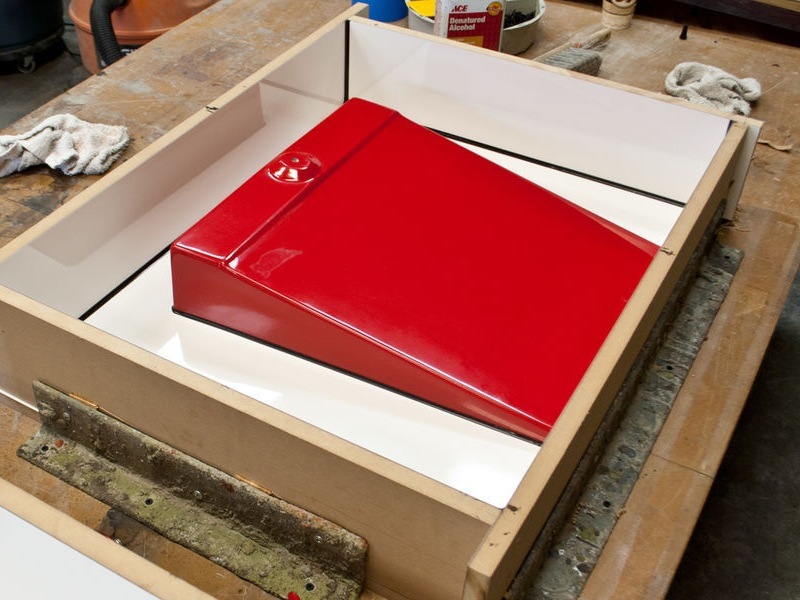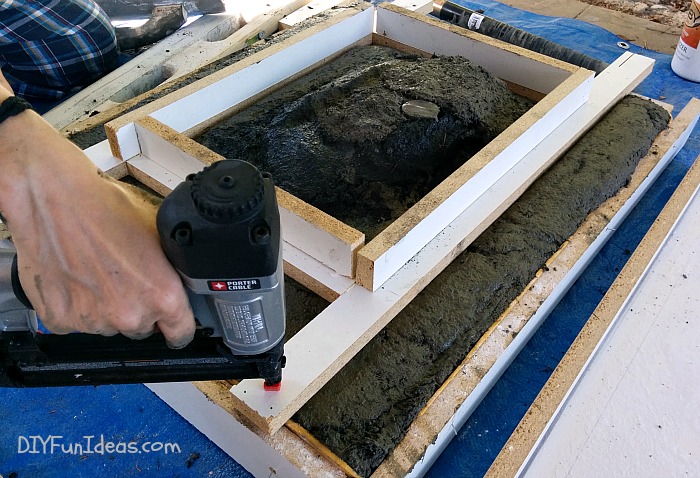To make a cement sink, create a mold, mix the cement, pour it, and let it cure. Then, remove the mold and finish the surface.
Crafting a cement sink can be a rewarding DIY project. Cement sinks offer a modern, industrial look that enhances any bathroom or kitchen. This guide will walk you through the process, from creating the mold to the final touches. With the right materials and tools, you can build a durable and stylish sink.
Cement sinks are not only functional but also customizable to match your design preferences. Whether you are a seasoned DIY enthusiast or a beginner, this project is achievable. Follow these steps to create a unique cement sink that will be the centerpiece of your space.
Introduction To Diy Cement Sinks
Creating your own cement sink can be a fun and rewarding project. It allows you to design a unique piece for your home. The process is simple and the results can be stunning. Cement sinks add a touch of modern elegance to any bathroom or kitchen. This guide will help you understand the basics and benefits of making your own cement sink.
The Appeal Of Cement In Home Decor
Cement is a versatile material that fits well with various home decor styles. It blends seamlessly with both rustic and contemporary designs. A cement sink can become a focal point in your space. Its natural, earthy texture brings a touch of nature indoors.
Cement’s durability is another reason for its appeal. It can withstand daily use and still look great. Cement sinks are resistant to scratches and heat. This makes them perfect for busy kitchens and bathrooms.
Benefits Of Crafting Your Own Sink
Personalization is a major benefit of making your own cement sink. You can choose the size, shape, and color. This ensures the sink fits your space perfectly. It also allows you to create a unique piece that reflects your style.
Cost savings is another advantage. Ready-made cement sinks can be expensive. By crafting your own, you save money. You only need basic materials and tools. This makes it an affordable project for any DIY enthusiast.
Sense of accomplishment is a rewarding aspect of this project. Creating something with your own hands can be very satisfying. Each time you use the sink, you’ll feel proud of your work.
Here’s a quick overview of what you need to start:
| Materials | Tools |
|---|---|
| Cement mix | Concrete mixer |
| Water | Mold |
| Sealer | Sanding paper |
These simple materials and tools are all you need to start your DIY cement sink project. Happy crafting!
Tools And Materials Needed
Creating a cement sink is an exciting DIY project. It requires specific tools and materials. Let’s explore what you need to get started.
Essential Tools For The Job
Gathering the right tools is crucial for a successful project. Here’s a list of essential tools:
- Concrete Mixer: This helps you mix the cement thoroughly.
- Trowel: For spreading and smoothing the cement.
- Rubber Gloves: Protects your hands from the cement.
- Bucket: Used for mixing water and cement.
- Measuring Tape: Ensures accurate measurements.
- Sandpaper: For smoothing out any rough edges.
- Mold: Shapes the cement into a sink.
Selecting The Right Cement Mix
The type of cement mix you choose impacts the durability and appearance of your sink. Consider these options:
| Cement Type | Benefits |
|---|---|
| Portland Cement | Strong and durable, ideal for sinks. |
| Quick-Set Cement | Dries faster, perfect for quick projects. |
| High-Strength Concrete | Withstands heavy use, great for long-term use. |
Additional Supplies For Customization
Adding unique touches to your cement sink makes it stand out. Here are some additional supplies:
- Color Pigments: These give your sink a custom color.
- Sealer: Protects the cement from water and stains.
- Decorative Stones: Adds a unique texture and design.
- Stencils: For creating patterns on your sink.
- Polishing Pads: Gives your sink a smooth, shiny finish.
Designing Your Sink
Designing your cement sink is an exciting step. This is where you can let your creativity shine. You will decide on the shape, size, and style of your sink. Each choice will impact the overall look and functionality of your sink. Let’s dive into the details!
Choosing The Perfect Shape And Size
First, think about the space where the sink will go. Measure the area carefully. This will help you decide the size of your sink. You want it to fit perfectly in the space.
Next, consider the shape of your sink. Common shapes include rectangles, squares, and ovals. Each shape has its own charm. Rectangles give a modern look. Squares are compact and neat. Ovals offer a smooth and elegant feel.
| Shape | Features |
|---|---|
| Rectangle | Modern look, fits in long spaces |
| Square | Compact, neat appearance |
| Oval | Elegant, smooth lines |
Creating A Template For Consistency
Creating a template is crucial for a consistent look. A template helps you shape your sink accurately. Use a sturdy material like plywood for your template.
Here are the steps to create a template:
- Draw your sink shape on the plywood.
- Cut out the shape using a saw.
- Sand the edges to make them smooth.
Check the template against your measurements. Make sure it fits the space perfectly. This will ensure that your sink turns out just right.
Using a template saves time. It also reduces errors in your sink design. This step is essential for creating a beautiful and functional cement sink.
Safety First: Precautions And Preparation
Creating a cement sink can be a rewarding DIY project. But safety must be your top priority. Proper precautions and thorough preparation are essential to avoid accidents and ensure a smooth process.
Protective Gear And Safe Handling
Before starting, gather your protective gear. This includes:
- Safety goggles to protect your eyes from dust and debris.
- Gloves to shield your hands from cement and tools.
- Dust mask to avoid inhaling cement particles.
- Long-sleeved clothing to cover exposed skin.
When handling cement, always use safe handling practices. Cement can cause skin irritation and respiratory issues. Make sure to work in a well-ventilated area. Keep a first aid kit nearby for emergencies.
Preparing Your Workspace
Preparing your workspace is crucial for a successful project. Follow these steps:
- Choose a clean, flat area to work. This will help prevent accidents and ensure a smooth surface for your sink.
- Lay down a protective covering. Use plastic sheeting or a tarp to catch spills and debris.
- Organize your tools and materials. Arrange them within easy reach to avoid unnecessary movement and reduce the risk of accidents.
- Ensure proper lighting. A well-lit workspace helps you see details clearly and avoid mistakes.
By following these precautions and preparation steps, you set the stage for a safe and successful cement sink project.
Building The Mold
Creating a cement sink starts with building a mold. The mold shapes the sink. It determines the final look and size. Let’s explore the steps to build a perfect mold.
Materials For Mold Making
- Plywood sheets
- Wood screws
- Wood glue
- Measuring tape
- Caulk
- Drill
- Saw
- Sandpaper
- Plastic sheeting
Assembling The Mold Step-by-step
- Measure and cut plywood sheets to the desired size of the sink.
- Assemble the base using wood screws and wood glue. Ensure corners are square.
- Attach the sides to the base. Use screws and glue for a sturdy frame.
- Seal the edges with caulk. This prevents cement from leaking out.
- Sand the inner surfaces of the mold. This ensures a smooth sink finish.
- Line the mold with plastic sheeting. This helps release the sink once dry.
Following these steps, you create a solid mold. Your cement sink will take shape perfectly. Take your time and ensure accuracy.

Credit: www.concreteexchange.com
Mixing And Pouring The Cement
Creating a cement sink involves precise steps. Mixing and pouring the cement is crucial. This ensures the final product is both durable and visually appealing. Follow these guidelines for optimal results.
Achieving The Ideal Consistency
Begin by gathering your materials. You need cement, water, and a mixing container. Use a bucket or a wheelbarrow. The ratio of water to cement is key. Aim for a smooth, paste-like consistency. Too much water can weaken the cement. Too little water makes it hard to work with.
- Pour the dry cement into the mixing container.
- Add water slowly, stirring continuously.
- Check the consistency frequently. It should be smooth and moldable.
Tip: Use a mixing paddle or a drill with a mixer attachment. This ensures even mixing and saves time.
Techniques For A Smooth Pour
Once the cement is mixed, prepare your mold. Ensure the mold is clean and dry. This prevents imperfections in the final product. Apply a release agent to the mold. This helps remove the sink once the cement sets.
Pour the cement slowly into the mold. Pouring too quickly can cause air bubbles. Use a trowel to spread the cement evenly. Tap the sides of the mold gently. This helps release trapped air and creates a smoother surface.
- Pour cement into the mold in layers.
- Use a trowel to smooth each layer.
- Tap the mold to release air bubbles.
Allow the cement to set undisturbed. Setting time can vary based on the type of cement and environmental conditions. Typically, it takes 24 to 48 hours.
By following these steps, you will achieve a smooth and durable cement sink. Pay attention to the consistency and pouring techniques. This ensures a professional finish and long-lasting durability.
Curing And Demolding Process
The curing and demolding process is crucial for a successful cement sink. Proper curing ensures the cement reaches its full strength. Carefully demolding the sink prevents damage. Follow these steps for best results.
Timeframes For Curing Cement
Curing cement requires patience. The recommended curing time is at least 28 days. This ensures the cement is strong and durable.
During the first week, keep the cement moist. Spray it with water daily. This prevents cracks.
After the first week, let the cement dry naturally. Avoid rushing the process. Patience pays off with a strong sink.
Carefully Removing The Sink From The Mold
After curing, it’s time to demold the sink. Start by loosening the edges. Use a soft tool to avoid damage.
Next, gently lift the sink from the mold. Avoid forcing it. If it resists, check for missed spots.
Once removed, inspect the sink for flaws. Smooth any rough areas with sandpaper. Your cement sink is now ready for use!
| Step | Description |
|---|---|
| Week 1 | Keep the cement moist by spraying with water daily |
| Week 2-4 | Allow the cement to dry naturally |
| Demolding | Carefully remove the sink from the mold and inspect |
- Patience is key during the curing process.
- Moisture helps prevent cracks in the first week.
- Gently remove the sink to avoid damage.
Finishing Touches
After molding and curing your cement sink, the finishing touches are crucial for a polished look. This final step ensures durability and enhances the sink’s aesthetic appeal.
Sanding And Sealing The Surface
Start by sanding the surface of your cement sink. Use fine-grit sandpaper to smooth out any rough areas. Sand in a circular motion to achieve an even finish.
Next, apply a concrete sealer. This step is essential to protect the sink from water damage. Use a paintbrush or roller for an even coat. Allow the sealer to dry completely before proceeding.
For extra protection, consider applying a second coat of sealer. This ensures your sink will withstand daily use.
Installing The Drain And Faucet
With the surface sealed, it’s time to install the drain and faucet. Begin by positioning the drain in the sink’s pre-drilled hole. Ensure it fits snugly.
Next, apply a bead of plumber’s putty around the drain’s lip. Press the drain firmly into place and tighten the locking nut underneath the sink.
To install the faucet, follow the manufacturer’s instructions. Typically, this involves securing the faucet in the designated holes. Tighten all connections to prevent leaks.
Double-check all fittings and connections to ensure everything is secure. Test the faucet and drain to make sure they function properly.
| Step | Tools Needed | Time Required |
|---|---|---|
| Sanding | Fine-grit sandpaper | 30 minutes |
| Sealing | Concrete sealer, paintbrush/roller | 1 hour (drying time) |
| Drain Installation | Plumber’s putty, wrench | 20 minutes |
| Faucet Installation | Wrench, manufacturer’s instructions | 30 minutes |
Following these steps ensures a professional finish for your cement sink. Enjoy the satisfaction of a job well done!
Installation And Maintenance
Installing and maintaining a cement sink can seem challenging. But with the right steps, it becomes manageable. This section will cover how to mount your sink and care for it long-term.
Mounting Your Sink
Mounting your cement sink involves several crucial steps. Follow these guidelines to ensure stability and safety:
- Prepare the area: Ensure the surface is level and clean.
- Place the sink: Position the sink over the pre-drilled holes.
- Secure it: Use bolts and washers to fasten the sink.
- Seal the edges: Apply silicone sealant around the edges to prevent water leakage.
- Connect the plumbing: Attach the sink to the water supply and drainage system.
Long-term Care For Your Cement Sink
Proper care extends the life of your cement sink. Follow these tips for long-term maintenance:
- Clean regularly: Use a mild detergent and a soft cloth.
- Avoid harsh chemicals: They can damage the surface.
- Seal annually: Apply a concrete sealer to protect against stains and cracks.
- Check for damage: Inspect for chips or cracks and repair them promptly.
- Maintain plumbing: Ensure there are no leaks or clogs in the drainage system.
| Task | Frequency |
|---|---|
| Clean the sink | Weekly |
| Seal the surface | Annually |
| Inspect for damage | Monthly |
| Maintain plumbing | As needed |
By following these steps, you can enjoy a beautiful and functional cement sink for years.
Troubleshooting Common Issues
Making a cement sink can be fun but sometimes issues arise. Knowing how to fix these problems is key. Below are some tips to help you troubleshoot common issues when making your cement sink.
Dealing With Cracks And Imperfections
Cracks and imperfections can appear in your cement sink. These flaws can make your sink look bad. Here are some steps to fix these issues:
- Identify the cracks: Look for any visible cracks or imperfections.
- Clean the area: Use a brush to clean the cracked area.
- Fill the cracks: Use a cement patching compound to fill the cracks.
- Smooth the surface: Use a trowel to smooth out the patched area.
- Let it dry: Allow the patch to dry completely before using the sink.
Tips For Repair And Restoration
Restoring a cement sink can make it look new again. Here are some tips for repairing and restoring your cement sink:
- Inspect the sink: Check for any damage or wear.
- Clean the sink: Use a gentle cleaner to remove dirt and grime.
- Sand the surface: Use fine-grit sandpaper to smooth out rough areas.
- Apply a sealer: Use a concrete sealer to protect the sink.
- Polish the sink: Use a polishing compound to give it a shiny finish.
By following these tips, you can keep your cement sink looking great. Addressing issues promptly will ensure your sink lasts for years.
Showcasing Your Handcrafted Sink
Creating a cement sink is an amazing achievement. Once you complete your project, you will want to showcase it in the best way possible. This section will guide you on how to display your handcrafted sink proudly.
Styling Your Bathroom Or Kitchen
Proper styling can enhance the beauty of your handcrafted sink. Here are some ideas to make it stand out:
- Choose the right countertop: A wooden or marble countertop can complement your cement sink.
- Use matching fixtures: Select faucets and handles that go well with the cement texture.
- Decorate with plants: Small potted plants can add a fresh touch to your sink area.
- Install good lighting: Proper lighting can highlight the details of your sink.
A well-styled bathroom or kitchen not only looks great but also makes your sink the focal point.
Sharing Your Diy Success
After completing your cement sink, share your success with others. Here are some ways to do it:
- Post on social media: Share pictures and videos of your sink on platforms like Instagram and Facebook.
- Write a blog post: Document the process and share tips on your blog.
- Join DIY forums: Participate in online communities and share your experience.
- Host a housewarming party: Invite friends and family to see your new creation.
Sharing your work can inspire others and give you a sense of accomplishment.

Credit: diyfunideas.com
Additional Resources And Inspiration
Creating a cement sink can be a rewarding project. With the right resources and inspiration, you can craft a beautiful and functional piece. Below are some additional resources to help you on your DIY journey.
Further Reading For Diy Enthusiasts
For those who love do-it-yourself projects, there’s a wealth of information available. Here are some helpful articles and books:
- “The Complete Guide to DIY Projects” – A comprehensive book covering all aspects of home improvement.
- “Concrete Countertops Made Simple” – This book offers step-by-step instructions for creating concrete surfaces.
- DIY Network’s Guide to Making a Concrete Sink – An online guide with photos and detailed steps.
Communities For Diy Home Improvement
Engaging with a community can provide support and ideas. Here are some popular online communities:
| Community | Description | Link |
|---|---|---|
| Reddit – r/DIY | A subreddit where DIY enthusiasts share their projects. | Visit r/DIY |
| Houzz | An online community with home improvement ideas and advice. | Visit Houzz |
| Instructables | A platform where users post step-by-step DIY guides. | Visit Instructables |
These resources and communities can provide valuable insight and inspiration. Happy crafting!

Credit: m.youtube.com
Frequently Asked Questions
How To Make A Sink With Cement?
To make a cement sink, create a mold with wood. Mix cement and water. Pour the mixture into the mold. Let it cure for 48 hours. Remove the mold and smooth the surface. Seal the sink to prevent water damage.
Is A Concrete Sink A Good Idea?
Yes, a concrete sink is a good idea. It offers durability, customization, and a modern look. Proper sealing prevents stains.
Can You Use Concrete For A Sink?
Yes, you can use concrete for a sink. It is durable, customizable, and offers a modern look. Ensure proper sealing to prevent stains and cracks.
How Thick Does A Concrete Sink Need To Be?
A concrete sink should generally be at least 1. 5 to 2 inches thick. This ensures strength and durability.
Conclusion
Crafting a cement sink can be a rewarding project. It adds a unique touch to any space. With patience and the right materials, you can create a stunning, durable sink. Follow the steps carefully, and soon you will have a custom cement sink.
Start your DIY journey today and enjoy the results.





